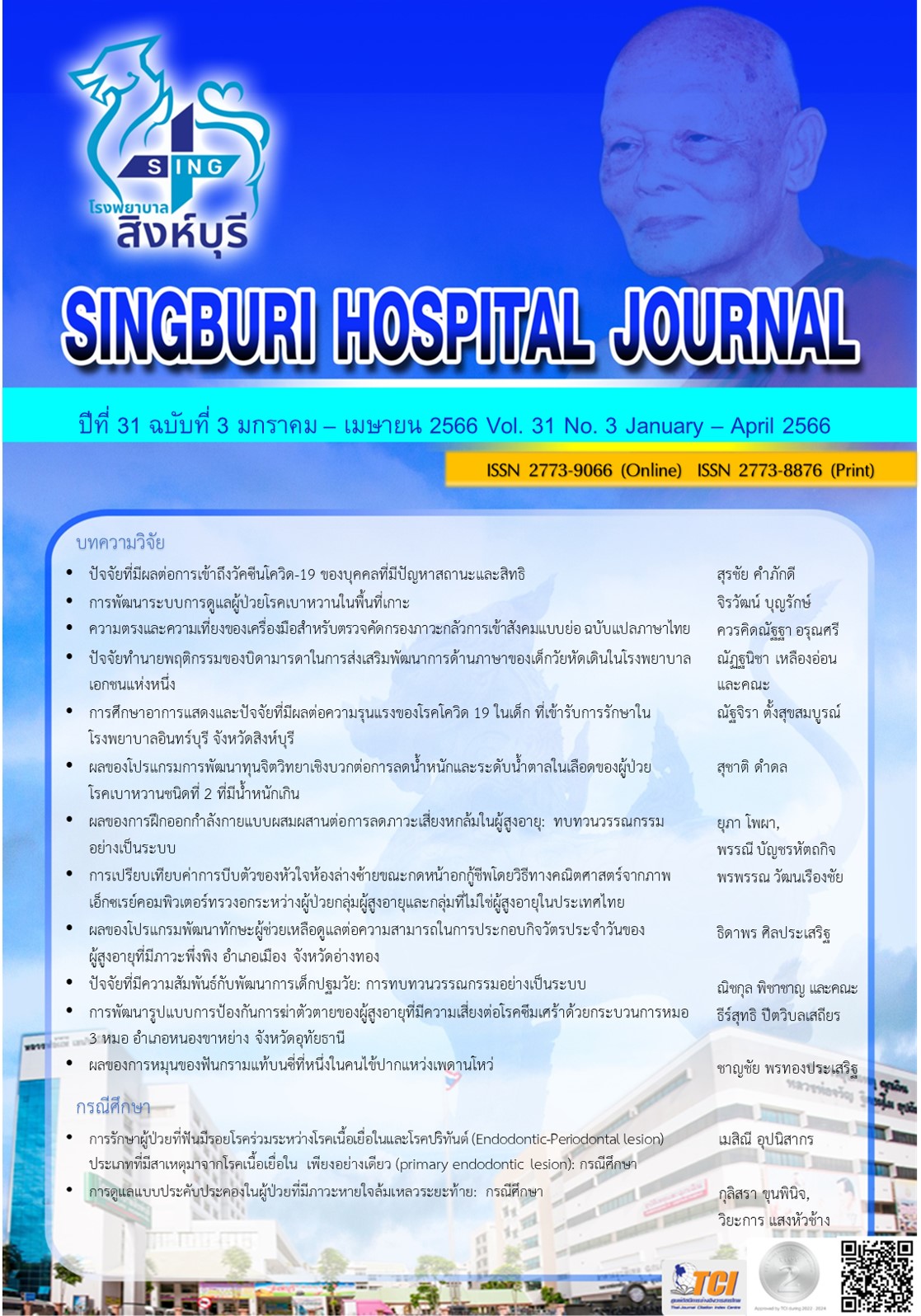ความตรงและความเที่ยงของเครื่องมือสำหรับตรวจคัดกรองภาวะกลัวการเข้าสังคมแบบย่อฉบับแปลภาษาไทย
คำสำคัญ:
ความตรง, ความเที่ยง, ภาวะกลัวการเข้าสังคมบทคัดย่อ
ความเป็นมา: ในปัจจุบัน เครื่องมือสำหรับตรวจคัดกรองภาวะกลัวการเข้าสังคมสำหรับผู้ใหญ่ในประเทศไทยยังมีจำนวนจำกัด ในปี ค.ศ. 2008 เครื่องมือสำหรับตรวจคัดกรองภาวะกลัวการเข้าสังคมแบบย่อเป็นแบบสอบถามซึ่งให้ผู้ตอบแบบสอบถามด้วยตนเองได้ผ่านการทดสอบความตรงและความเที่ยงเพื่อใช้เป็นเครื่องมือประเมินภาวะกลัวการเข้าสังคมในประชากรในประเทศสเปน
วัตถุประสงค์: เพื่อศึกษาความตรง (validity) และความเที่ยง (reliability) ของเครื่องมือสำหรับตรวจคัดกรองภาวะกลัวการเข้าสังคมแบบย่อ (Brief form of The Social Phobia and Anxiety Inventory: SPAI-B)) ฉบับแปลภาษาไทย
วิธีการศึกษา: หลังจากได้การอนุมัติจากเจ้าของลิขสิทธิ์ เครื่องมือ SPAI-B ต้นฉบับ ถูกนำมาแปลเป็นภาษาไทยโดยเทคนิคการแปลแบบย้อนกลับ อาสาสมัครจำนวน 163 รายได้ถูกสุ่มเลือก เพื่อตอบแบบประเมิน SPAI-B ฉบับภาษาไทยและได้รับการประเมินภาวะกลัวการเข้าสังคมโดยการวินิจฉัยโรคตามเกณฑ์สมาคมจิตแพทย์อเมริกันครั้งที่ 5 (DSM-5) ซึ่งเป็นการตรวจมาตรฐานสูงสุด (gold standard) และหาค่าสัมประสิทธิ์แอลฟ่าของครอนบาค (Cronbach α) เพื่อตรวจสอบความสอดคล้องภายในเนื้อหา (internal reliability) และค่าดัชนีความสอดคล้อง (Index of item objective congruence: IOC) เพื่อตรวจสอบความตรงตามเนื้อหา (content validity) ส่วนคะแนนจุดตัดของแบบประเมิน SPAI-B ฉบับภาษาไทยได้จาก Receiver Operating Characteristic (ROC) Curve
ผลการศึกษา: ค่า Cronbach’s alpha ของเครื่องมือ SPAI-B ฉบับแปลภาษาไทยเท่ากับ 0.95 ค่า point-biserial correlation coefficient ระหว่างคะแนน SPAI-B กับการวินิจฉัยภาวะกลัวการเข้าสังคม คือ 0.64 ค่าจุดตัดที่เหมาะสมโดยใช้ Receiver Operating Characteristic (ROC) Curve คือคะแนนตั้งแต่ 33 ขึ้นไป มีค่าความไว (sensitivity) เท่ากับ 0.94 และค่าความจำเพาะ (specificity) เท่ากับ 0.78
สรุป: เครื่องมือสำหรับตรวจคัดกรองภาวะกลัวการเข้าสังคมแบบย่อ (Brief form of The Social Phobia and Anxiety Inventory: SPAI-B) ฉบับแปลภาษาไทยมีความตรงและความเที่ยงอยู่ในเกณฑ์ดี สามารถนำมาใช้คัดกรองภาวะกลัวการเข้าสังคมในคนไทยได้อย่างมีประสิทธิภาพ
Downloads
เอกสารอ้างอิง
Stein DJ, Lim CCW, Roest AM, de Jonge P, Aguilar-Gaxiola S, Al-Hamzawi A, et al. The cross-national epidemiology of social anxiety disorder: Data from the World Mental Health Survey Initiative. BMC Medicine. 2017;15(1):143.
Jefferies P, Ungar M. Social anxiety in young people: A prevalence study in seven countries. PLoS One. 2020 Sep 17;15(9):1-18.
Seidi P. PREVALENCE OF SOCIAL ANXIETY IN STUDENTS OF COLLEGE OF EDUCATION-UNIVERSITY OF GARMIAN INTRODUCTION. International Journal of Arts and Technology. 2017; 8(1). 78-82.
Cheung R, O'Donnell S, Madi N, Goldner E. Factors associated with delayed diagnosis of mood and/or anxiety disorders. Facteurs associés au diagnostic tardif d'un trouble de l’humeur et/ou d’anxiété. Health Promot Chronic Dis Prev Can. 2017;37(5):137-148.
Remillard ML, Mazor KM, Cutrona SL, Gurwitz JH, Tjia J. Systematic review of the use of online questionnaires of older adults. J Am Geriatr Soc. 2014;62(4):696-705.
Knäuper B, Carrière K, Chamandy M, Xu Z, Schwarz N, Rosen NO. How aging affects self-reports. Eur J Ageing. 2016; 13(2): 185-193.
von Glischinski, M., Willutzki, U., Stangier, U., Hiller, W., Hoyer, J., Leibing, E., Leichsenring, F., & Hirschfeld, G. (2018). Optimal Cut Points for Remission and Response for the German Version of the Social Phobia Anxiety Inventory (SPAI). Zeitschrift Für Psychosomatische Medizin Und Psychotherapie, 64(2), 158–171.
Abdull Hamid, Fathi, and Mourad Ali Eissa. 2013. “Assessing Validity and Reliability of the Social Phobia and Anxiety Inventory for Children (SPAI-C) in a Sample of Egyptian School Children”. Psycho-Educational Research Reviews 2 (3):53-59.
Cederlund R, Ost LG. Psychometric properties of the social phobia and anxiety inventory-child version in a Swedish clinical sample. J Anxiety Disord. 2013 Jun;27(5):503-11.
Garcia-Lopez L, Hidalgo MD, Beidel D, Rodríguez J. Brief Form of the Social Phobia and Anxiety Inventory (SPAI-B) for Adolescents. European Journal of Psychological Assessment - EUR J PSYCHOL ASSESS. 2008;24:150-6.
García-López L-J, Beidel DC, Muela-Martínez JA, Espinosa-Fernández L. Optimal Cut-Off Score of Social Phobia and Anxiety Inventory-Brief Form: Detecting DSM-5 Social Anxiety Disorder and Performance-Only Specifier. European Journal of Psychological Assessment. 2018;34:278–82.
Ambusaidi A, Al-Huseini S, Alshaqsi H, AlGhafri M, Chan MF, Al-Sibani N, Al-Adawi S, Qoronfleh MW. The Prevalence and Sociodemographic Correlates of Social Anxiety Disorder: A Focused National Survey. Chronic Stress (Thousand Oaks). 2022 Mar 2;6:1-9.
Leigh E, Clark DM. Understanding Social Anxiety Disorder in Adolescents and Improving Treatment Outcomes: Applying the Cognitive Model of Clark and Wells (1995). Clin Child Fam Psychol Rev. 2018;21(3):388-414.
Samy A, Fazli Khalaf Z, Low WY. Mental Health in the Asia-Pacific Region: An Overview. International Journal of Behavioral Science. 2015;10:9-18.
Akdoğan R, Çimşir E. Collectivistic ambivalence: A potential source of social anxiety for individuals with higher inferiority feelings. International Journal of Intercultural Relations. 2022;89:195-207.
Hu H, Wu T, Wang S, Chen P, Zhang J, Zhao X. Association Between Family Structure and Anxiety Disorder Among Pre-schoolers: A Cross-Sectional Study in Urban Chongqing, China. Frontiers in Psychiatry. 2021;12.
ปัทมา ว่าพัฒนวงศ์. การอยู่อาศัยร่วมกันของสมาชิกในครัวเรือนไทย พ.ศ. 2539-2560: การจำแนกรูปแบบด้วยกลุ่มวัย. ใน: จงจิตต์ ฤทธิรงค์, ศุทธิดา ชวนวัน, สิรินทร์ยา พูลเกิด, สรัญญา สุจริตพงศ์.ครอบครัวไทย...สะท้อนอะไรในสังคม (The reflection of Thai families to Society). พิมพ์ครั้งที่ 1. นครปฐม: สำนักพิมพ์ประชากรและสังคม; 2562. หน้า 37-50.
Furstenberg FF. Family Change in Global Perspective: How and Why Family Systems Change. Fam Relat. 2019;68(3):326-341.
Capriola-Hall, N.N., Booker, J.A. & Ollendick, T.H. Parent- and Child-Factors in Specific Phobias: The Interplay of Overprotection and Negative Affectivity. J Abnorm Child Psychol 48, 1291–1302 (2020).
Yim EP-Y. Effects of Asian cultural values on parenting style and young children’s perceived competence: A cross-sectional study. Frontiers in Psychology. 2022;13.Seidi P. PREVALENCE OF SOCIAL ANXIETY IN STUDENTS OF COLLEGE OF EDUCATION-UNIVERSITY OF GARMIAN INTRODUCTION. International Journal of Arts and Technology. 2017; 8(1). 78-82.
ดาวน์โหลด
เผยแพร่แล้ว
รูปแบบการอ้างอิง
ฉบับ
ประเภทบทความ
สัญญาอนุญาต
ลิขสิทธิ์ (c) 2023 โรงพยาบาลสิงห์บุรี

อนุญาตภายใต้เงื่อนไข Creative Commons Attribution-NonCommercial-NoDerivatives 4.0 International License.
บทความที่ได้รับการตีพิมพ์เป็นลิขสิทธิ์ของโรงพยาบาลสิงห์บุรี
ข้อความที่ปรากฏในบทความแต่ละเรื่องในวารสารวิชาการเล่มนี้เป็นความคิดเห็นส่วนตัวของผู้เขียนแต่ละท่านไม่เกี่ยวข้องกับโรงพยาบาลสิงห์บุรี และบุคคลากรท่านอื่นๆในโรงพยาบาลฯ แต่อย่างใด ความรับผิดชอบองค์ประกอบทั้งหมดของบทความแต่ละเรื่องเป็นของผู้เขียนแต่ละท่าน หากมีความผิดพลาดใดๆ ผู้เขียนแต่ละท่านจะรับผิดชอบบทความของตนเองแต่ผู้เดียว







